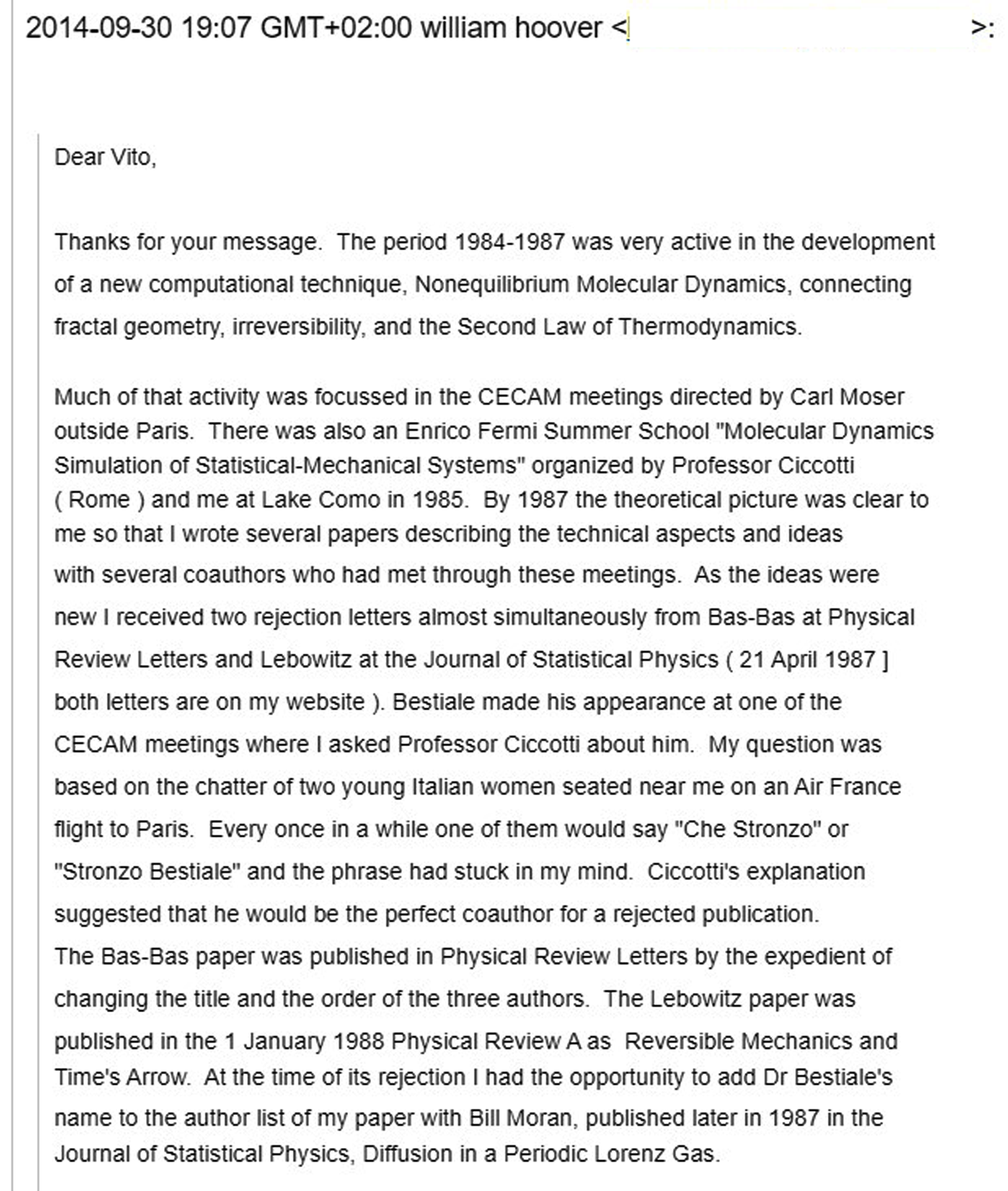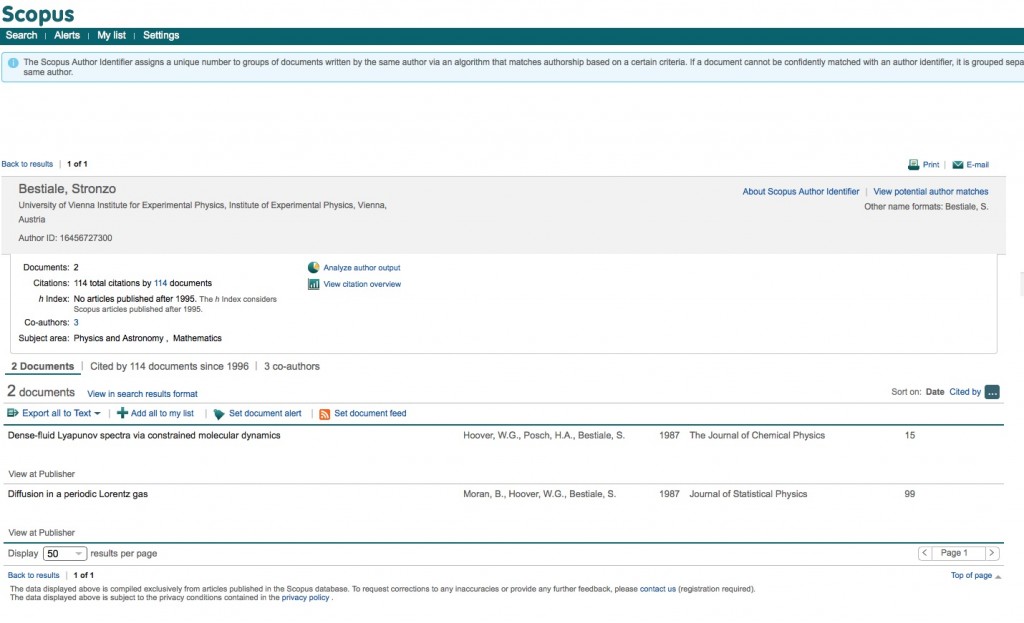 Would you read a paper written by Stronzo Bestiale (Total Asshole)? A dose of mistrust would be justified: the name says it all. Yet, in 1987, professor Bestiale, supposedly a physicist in Palermo, Sicily, authored major papers in prestigious scientific peer reviewed journals such as the Journal of Statistical Physics, the Journal of Chemical Physics and the proceedings of a meeting of American Physical Society in Monterey.
Would you read a paper written by Stronzo Bestiale (Total Asshole)? A dose of mistrust would be justified: the name says it all. Yet, in 1987, professor Bestiale, supposedly a physicist in Palermo, Sicily, authored major papers in prestigious scientific peer reviewed journals such as the Journal of Statistical Physics, the Journal of Chemical Physics and the proceedings of a meeting of American Physical Society in Monterey.Given that surnames always intrigued me (they are the subject of my first book), I tried to find this person in Italian telephone directories. In Italy there are 7 Bestiale, mostly in Piedmont. None of them, however, has the name Stronzo (Turd or a Asshole: who would call their own son that?); between the Veneto and Trentino-Alto Adige there are 4 Stronziero, but this is also a surname.
In fact, Stronzo Bestiale does not exist as confirmed, when those scientific papers were published 27 years ago, by the then Chancellor of the University of Palermo, Ignazio Melisenda Giambertoni (another unusual surname!).
So I decided to investigate more thoroughly. The self-styled Bestiale appears in the papers authored by Bill Moran and William G. Hoover, two influential American scientists from the Lawrence Livermore National Laboratory. In particular, Bestiale appears in various documents authored by Hoover, who also cited him at the end of a very serious physicspaper, saying that “discussions with him were very useful.”
I wrote an email to professor Hoover, now retired, to ask him the true story of Stronzo Bestiale. Here’s what he answered.
«At that time, the period 1984-1987» he says «we were very active in the development of a new computational technique, non-equilibrium molecular dynamics, connecting fractal geometry, irreversibility and the second law of thermodynamics. The idea was born during meetings at CECAM (Centre Européen de Calcul Atomique et Moléculaire) in Lausanne, Switzerland, and the Enrico Fermi summer school organized at Lake Como with Giovanni Ciccotti, professor of condensed matter physics at the University La Sapienza University in Rome. In these meetings, the theoretical picture of this technique was clear to me, so I wrote several papers on the subject along with some colleagues». But the reviewers of Physical Review Letters and the Journal of Statistical Physics refused to publish his texts: they contained too innovative ideas.
This is nothing new: new discoveries in science are hard to publish because scientists are rather conservative, as discussed by the epistemologist Thomas Kuhn. Meanwhile, Hoover continues, «while I was traveling on a flight to Paris, next to me were two Italian women who spoke among themselves, saying continually: “Che stronzo (what an asshole)!”, or “Stronzo bestiale (total asshole)”. Those phrases had stuck in my mind. So, during a CECAM meeting, I asked Ciccotti what they meant. When he explained it to me, I thought that Stronzo Bestiale would have been the perfect co-author for a rejected publication». So he decided to submit his papers again, simply by changing the title and adding the name of that author. And the researches were published.
In short, a pointed joke. Not everyone took it well, at the time: the President of the Italian Physical Society, Professor Renato Angelo Ricci said, «This joke is an offense to the entire Italian scientific community». After receiving several calls in the editorial office from Italian readers asking for explanations about that vulgar author, the editor of the “Journal of statistical physics”, Joel Lebowitz, published a letter of apology in the March 1988 issue: “It has come to my attention that the name given as the third author in the above paper is in fact a rather obscene expression in Italian. I apologize to the readers for not catching this stupidity of the other two authors. ”. The rectification, as often happens, went unnoticed.
In reality, though, this joke laid bare how vulnerable control systems in the review of scientific research were (and still are!) . If you are able to insert in a publication the name of a nonexistent author in a publication, who will guarantee that even the scientific contents have been examined with care? Incredibly, even today, 27 years later, Stronzo Bestiale continues to be present as the author of publications in scientific databases: is it not extraordinary?
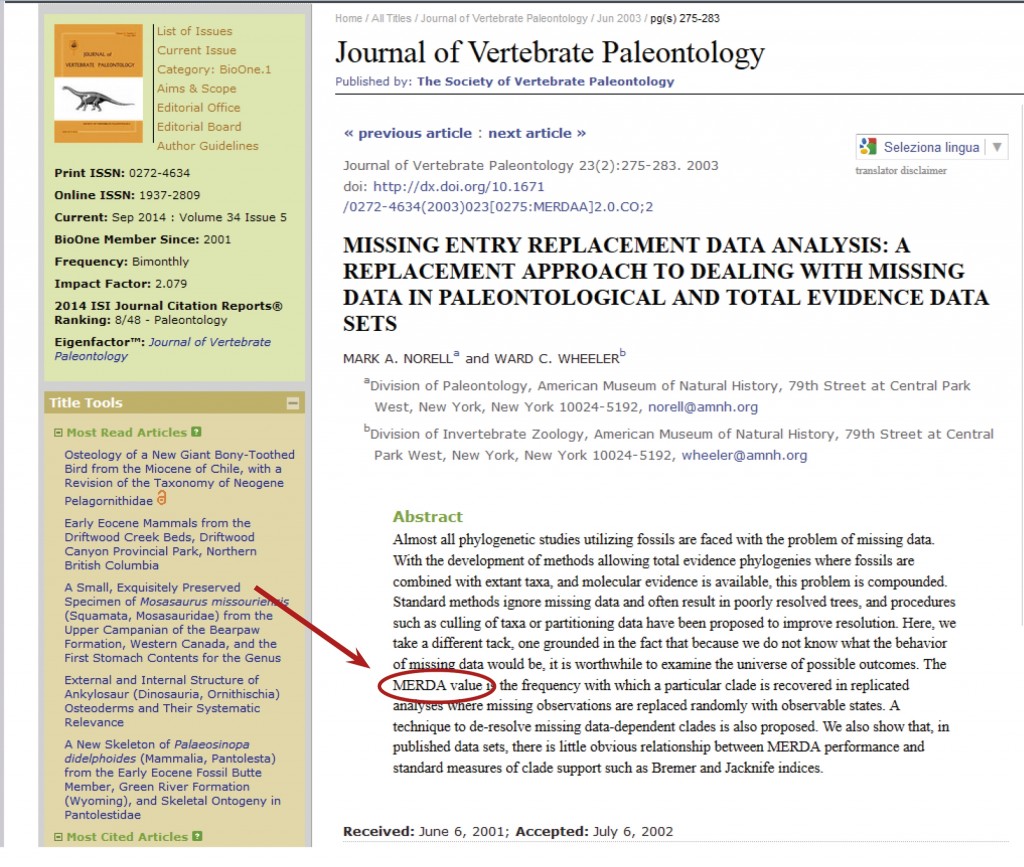 But Stronzo Bestiale is not the only dirty word published in international scientific journals. More recently, in 2003, the Journal of Vertebrate Paleontology published a study on the “MERDA (shit) value”, which stands for Missing Entry Replacement Data Analysis, a technique for phylogenetic reconstruction in paleontology.
But Stronzo Bestiale is not the only dirty word published in international scientific journals. More recently, in 2003, the Journal of Vertebrate Paleontology published a study on the “MERDA (shit) value”, which stands for Missing Entry Replacement Data Analysis, a technique for phylogenetic reconstruction in paleontology.Was this an embarrassing coincidence that the authors realized only after the fact? Far from it!
I asked one of the authors, Ward C. Wheeler, of the division of invertebrate zoology at the American Museum of Natural History for clarification. And he revealed that they knew very well the meaning of “merda” from Catalan: not Italian, but it makes no difference … «We chose that acronym on purpose, to highlight the poor quality of incomplete groups of data. It was a amusing acronym. The procedure, which in the meantime has been further developed, it is still used for the analysis of incomplete fossils samples».
So, scientists do have sense of humor. Fortunately. As for people with vulgar surnames … they do exist. In Italy there are thousands. I will tell their stories in the next post. [click here for italian version ]
UPDATE #1: my collegue Fabio Turone, president of SWIM (Science Writers in Italy, an association of science journalists) sent me the profile of Stronzo Bestiale from Scopus, an international bibliographic and bibliometric database (see screenshot below). In Scopus, professor Stronzo Bestiale appears to be working at the Institute of Experimental Physics, at the University of Vienna, the institutional affiliation attributed to him in the paper published by the Journal of chemical physics. One more point on his résumé!
UPDATE #2: italian research also has had a funny episode with dirty words. Some readers of this blog report a Prin (Research project of relevant national interest), presented in 2011 by researchers from INFN and University of Torino. It was a virtual analysis system for the LHC particle accelerator at CERN in Geneva. The acronym of the system was Vaffa (an abbreviation of vaffanculo, fuck off): Virtual Analysis Facility For the Alice experiment. The project, which you can read about here, was not approved.
 UPDATE #3: a reader of this blog, Ugo Finardi, points out antenna FICA (acronym of Folded Inverted Conformal Antenna): in italian, FICA means cunt. It’s not a coincidence, because this antenna was invented by an Italian couple of engineers who, at the time, worked in the research laboratories of Motorola in the United States, Carlo Di Nallo and Antonio Faraone. The invention has been presented in 2005 at the international symposium of the IEEE (Institute of Electrical and Electronic Engineers).
UPDATE #3: a reader of this blog, Ugo Finardi, points out antenna FICA (acronym of Folded Inverted Conformal Antenna): in italian, FICA means cunt. It’s not a coincidence, because this antenna was invented by an Italian couple of engineers who, at the time, worked in the research laboratories of Motorola in the United States, Carlo Di Nallo and Antonio Faraone. The invention has been presented in 2005 at the international symposium of the IEEE (Institute of Electrical and Electronic Engineers).
UPDATE #4: the funny story of Stronzo Bestiale had an international resonance. It’s cited by american blog RetractionWatch, an observatory of retractions and corrections in scientific papers, edited by Ivan Oransky, professor of medicine at New York University School of Medicine and editorial director of MedPage Today. Oransky recalls a similar case: the immunologist Polly Matzinger, who in 1978 published a study co-authored by entering Galadriel Mirkwood: the name of her afghan hound. It was a way to protest against the use of passive voice in scientific papers (“it was discovered that …”).
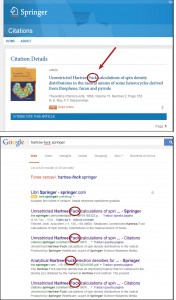 UPDATE #5: the Hartree-Fock method is a procedure in computational physics, which is used to simulate quantum systems. It is named by its discoverers Douglas Hartree and Vladimir Fock. The latter is a Russian physicist with a surname that, in English, is likely to be crippled so vulgar (fuck). And in fact, their method – at a distance of 46 years after the paper that this discovery – has become Hartree-Fuck in Springer publisher’s website (click image to enlarge). And if you type in Google “Hartree-Fuck Springer”, you will get different results mentioning Fuck in the title. Difficult to determine whether it was a mistake or a joke. Or a way to get more clicks on the Web (even by those who make mistakes typing the name)?
UPDATE #5: the Hartree-Fock method is a procedure in computational physics, which is used to simulate quantum systems. It is named by its discoverers Douglas Hartree and Vladimir Fock. The latter is a Russian physicist with a surname that, in English, is likely to be crippled so vulgar (fuck). And in fact, their method – at a distance of 46 years after the paper that this discovery – has become Hartree-Fuck in Springer publisher’s website (click image to enlarge). And if you type in Google “Hartree-Fuck Springer”, you will get different results mentioning Fuck in the title. Difficult to determine whether it was a mistake or a joke. Or a way to get more clicks on the Web (even by those who make mistakes typing the name)?
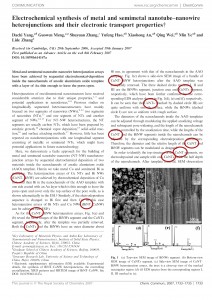 UPDATE #6: a reader of this blog, Andrew White, points out two other vulgar acronyms, contained in a 2007 survey on the electrochemical synthesis of nanotubes: BINT (Bismuth nanotubes, nanorods of bismuth) and CUNT (Cu stands for copper: click image to enlarge). Since this is a research written by Chinese authors, it was almost certainly an accident. But it seems that among chemists had a considerable popularity.
UPDATE #6: a reader of this blog, Andrew White, points out two other vulgar acronyms, contained in a 2007 survey on the electrochemical synthesis of nanotubes: BINT (Bismuth nanotubes, nanorods of bismuth) and CUNT (Cu stands for copper: click image to enlarge). Since this is a research written by Chinese authors, it was almost certainly an accident. But it seems that among chemists had a considerable popularity.
UPDATE #7: professor Mark Liberman, linguist at Pennsylvania University, points out many papers signed Connard (in French, connard means shithead). I checked if one of the most prolific authors, a geologist from Oregon, Gerald G. Connard, really exists: in telephone directories he is present, and probably others. Moreover, people with a vulgar surname are many: among them there must be some scientist!
 UPDATE #8: this morning I discovered that a Us company, Albany Retro Snarky T-Shirts, created a T-shirt about this story, with the inscription “I’m friends with Stronzo Bestiale“. The catch-phrase: “The super funny T-shirt for any scientist!”. Perhaps professor Hoover and me should ask the royalties on this business…
UPDATE #8: this morning I discovered that a Us company, Albany Retro Snarky T-Shirts, created a T-shirt about this story, with the inscription “I’m friends with Stronzo Bestiale“. The catch-phrase: “The super funny T-shirt for any scientist!”. Perhaps professor Hoover and me should ask the royalties on this business… 
UPDATE #9: the Improbable Research organization has re-launched on its website the Stronzo Bestiale story (under “improbable investigators”). Maybe one day prof. Bestiale could win an IgNobel: after a so long carrer, he’d deserve it! Do we candidate him?
 UPDATE #9: Stronzo Bestiale’s story has been reported on Science website.
UPDATE #9: Stronzo Bestiale’s story has been reported on Science website.
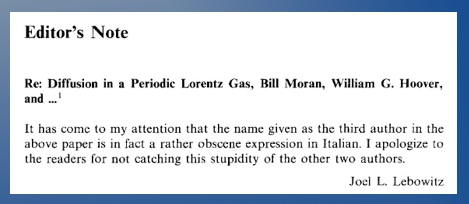 UPDATE #10: also “Scientific american” website tells the Stronzo Bestiale story for the april fool day. The author, Philip Yam, also found a backstory: after the article by Hoover was published, the production editor of the Journal of Statistical Physics, Jim Langlois, received a call from an italian journalist, who asked explanations for this unusual author. And he also explained the meaning of “stronzo bestiale” in Italian. So the joke came to light: in the next issue, the editor Joel Lebowitz wrote an article of apology: “It has come to my attention that the name given as the third author in the paper is a rather obscene expression in Italian. I apologize to the readers for not catching this stupidiy of the other two authors. “
UPDATE #10: also “Scientific american” website tells the Stronzo Bestiale story for the april fool day. The author, Philip Yam, also found a backstory: after the article by Hoover was published, the production editor of the Journal of Statistical Physics, Jim Langlois, received a call from an italian journalist, who asked explanations for this unusual author. And he also explained the meaning of “stronzo bestiale” in Italian. So the joke came to light: in the next issue, the editor Joel Lebowitz wrote an article of apology: “It has come to my attention that the name given as the third author in the paper is a rather obscene expression in Italian. I apologize to the readers for not catching this stupidiy of the other two authors. “
 UPDATE #11: two false profiles of Stronzo Bestiale have been published on Linkedin: one is the “head of quantitative analysis” at a London betting syndicate, the other is a self-styled student from Romagna (Italy) at the University of Leiden. Both have no follower: but their existence testifies that the myth of prof. Bestiale remains alive … even in the professional field!
UPDATE #11: two false profiles of Stronzo Bestiale have been published on Linkedin: one is the “head of quantitative analysis” at a London betting syndicate, the other is a self-styled student from Romagna (Italy) at the University of Leiden. Both have no follower: but their existence testifies that the myth of prof. Bestiale remains alive … even in the professional field!
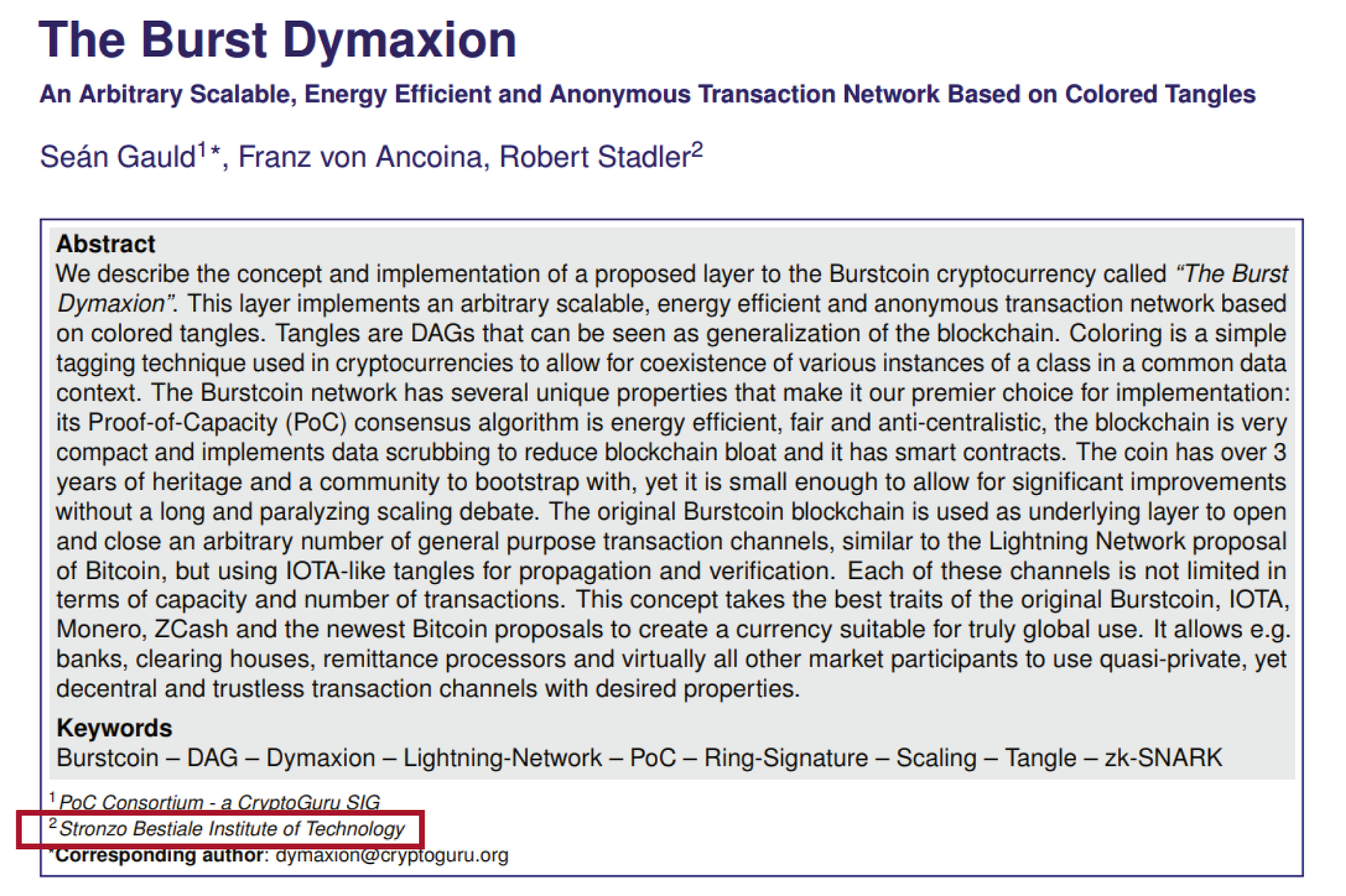 UPDATE #12: Stronzo Bestiale reappeared in a new research published in 2017 on the burst-coin.org website. It’s called “The burst Dymaxion” and talks about cryptocurrencies. Among the authors there is a certain Robert Stadler, who qualifies as a member of the Stronzo Bestiale Institute of Technology, obviously non-existent. And Stadler is also likely to be a pseudonym, given that on the Web the only Stadler that is mentioned is an Austrian designer who has nothing to do with cryptocurrencies. In short, a fake name of a very false institution: among researchers dealing with digital currencies, anonymity is quite common. And in this case there is a note of mocking. [thanks to the biologist Claudio Tiecher who reported it].
UPDATE #12: Stronzo Bestiale reappeared in a new research published in 2017 on the burst-coin.org website. It’s called “The burst Dymaxion” and talks about cryptocurrencies. Among the authors there is a certain Robert Stadler, who qualifies as a member of the Stronzo Bestiale Institute of Technology, obviously non-existent. And Stadler is also likely to be a pseudonym, given that on the Web the only Stadler that is mentioned is an Austrian designer who has nothing to do with cryptocurrencies. In short, a fake name of a very false institution: among researchers dealing with digital currencies, anonymity is quite common. And in this case there is a note of mocking. [thanks to the biologist Claudio Tiecher who reported it].
UPDATE #13: the story of Stronzo Bestiale has been cited on 3 papers dedicated to the “dark side” of science, or to errors or frauds (or jokes, as in this case) that can be conveyed through scientific papers, despite the referee checks. The first study is by Ernesto Carafoli, of the Institute of Molecular Medicine of Padua, and it is intitled “Scientific misconduct: the dark side of science” (2015). The second is by Marta Brunelli, from the Department of Educational Sciences at the University of Macerata, and it is intitled “To peer review or not to peer review? Ovvero: come sopravvivere alle procedure di referaggio” (2015). The third is a study by Samuel Moore et al. (Kings College, London) entitled: “Excellence R Us: university research and the fetishisation of excellence” (2017).
UPDATE #14: a Spanish band, Sin Arreglo, has launched a crowdfunding to finance the recording of a record entitled “Stronzo bestiale”. An explicit tribute to the story told by this blog. The record was published in 2020: “Stronzo bestiale” is also a song (an instrumental one). You can hear it on YouTube.
UPDATE #15: a researcher from CERN in Geneva, Andrea Giammanco, wrote a novel, “Stable charged and massive particles“, which has as its protagonist professor Bestiale (but his name is Sergio). He is the team leader of the tiny group of the Palermo Institute for Advanced Studies. An obvious homage inspired by the story.
Did you like Stronzo Bestiale story? Here you can read a new, true one: dr. Fuck & Fuck, and their patient (a bitch, obvious).
 The international Press Review on this story (articles in English, French, Spanish, Portuguese, Greek, Polish, Russian, Chinese, Creole, Italian): → RassegnaStampaStronzoBestiale
The international Press Review on this story (articles in English, French, Spanish, Portuguese, Greek, Polish, Russian, Chinese, Creole, Italian): → RassegnaStampaStronzoBestiale
[ audio ] CHILE, radio Cooperativa (14/10/2014):
Todo es Cierto: Los artículos científicos de Stronzo Bestiale
En Lo que Queda del Día de Cooperativa Paula Molina conversó con el dramaturgo Andrés Kalawski, quien habló sobre los documentos científicos de Stronzo Bestiale y sus coautores.
 [ audio ] BBC radio 4, Inside Science (6/11/2014): from minute 21
[ audio ] BBC radio 4, Inside Science (6/11/2014): from minute 21
Thanks to Sara Scharf for the precious help in reviewing my translation.

La pagina ufficiale del paper firmato da Bestiale (clic per ingrandire).
Leggereste una ricerca scientifica firmata da Stronzo Bestiale? Una dose di diffidenza sarebbe giustificata: il nome è tutto un programma. Eppure, il professor Bestiale, fisico palermitano, ha firmato nel 1987 importanti studi su prestigiose riviste scientifiche, come il Journal of Statistical Physics, il Journal of Chemical Physics e gli atti di un congresso dell’American Physical Society a Monterey.
[ english version of this post here ]
Dato che i cognomi mi incuriosiscono da sempre (a loro ho dedicato il mio primo libro), ho cercato le tracce di questa persona negli elenchi telefonici. In Italia ci sono 7 Bestiale, per lo più in Piemonte. Nessuno di loro, però, ha il nome Stronzo (chi chiamerebbe così il proprio figlio?); tra Veneto e Trentino-Alto Adige ci sono 4 Stronziero, ma anche questo è un cognome.
E infatti, Stronzo Bestiale non esiste: l’aveva già dichiarato ufficialmente 27 anni fa, quando furono pubblicati quei paper scientifici, l’allora rettore dell’università di Palermo, Ignazio Melisenda Giambertoni (anch’egli un cognome insolito…).
Così ho deciso di indagare più a fondo. Il sedicente Bestiale appare nelle ricerche firmate da Bill Moran e William G. Hoover, due autorevoli scienziati statunitensi del Laboratorio Nazionale Lawrence Livermore. In particolare, Bestiale appare in vari documenti di Hoover, che lo ha pure citato alla fine di un serissimo paper di fisica, dicendo che “le discussioni con lui erano state molto utili”.
Ho scritto a Hoover, oggi in pensione, per chiedergli la vera storia di Stronzo Bestiale. Ecco che cosa mi ha risposto.
«In quel periodo» racconta «eravamo molto attivi nello sviluppo di una nuova tecnica computazionale, la dinamica molecolare del non equilibrio, che connette la geometria frattale, l’irreversibilità e la seconda legge della termodinamica. L’idea era nata durante gli incontri al Cecam (Centre Européen de Calcul Atomique et Moléculaire) a Losanna, in Svizzera, e alla summer school Enrico Fermi organizzata al lago di Como insieme al professor Giovanni Ciccotti, docente di fisica della materia all’Università La Sapienza di Roma. In questi incontri il quadro teorico di questa tecnica mi si era chiarito, così scrissi diversi paper sull’argomento insieme ad alcuni colleghi». Ma i revisori delle Physical Review Letters e del Journal of Statistical Physics rifiutarono di pubblicare i suoi testi: contenevano idee troppo innovative.
Non è una novità: nella scienza le nuove scoperte fanno fatica ad affermarsi perché gli scienziati sono piuttosto conservatori, come aveva già constatato l’epistemologo Thomas Kuhn. Nel frattempo, continua Hoover, «mentre viaggiavo su un volo per Parigi, vicino a me c’erano due donne italiane che parlavano fra loro, dicendo continuamente: “Che stronzo!”, o “Stronzo bestiale”. Quelle frasi si erano stampate nella mia mente. Così, a uno dei meeting del Cecam, chiesi a Ciccotti cosa significassero. Quando me lo spiegò, ho pensato che Stronzo Bestiale sarebbe stato il coautore perfetto per una pubblicazione rifiutata. Così ho deciso di riproporre i miei paper, semplicemente cambiandone il titolo e aggiungendo il nome di quell’autore. E le ricerche furono pubblicate».
Insomma, uno scherzo, una provocazione mascherata. Non tutti la presero bene, all’epoca: il presidente della Società italiana di fisica, il professor Renato Angelo Ricci commentò: «Questo scherzo è un’ offesa all’intera comunità scientifica italiana». Dopo aver ricevuto in redazione diverse chiamate da lettori italiani che chiedevano spiegazioni su quel volgare firmatario, il direttore del “Journal of statistical physics”, Joel Lebowitz, ha pubblicato una lettera di scuse sul numero di marzo del 1988: “Mi è stato segnalato che il nome attribuito al terzo autore della summenzionata ricerca è invece un’espressione piuttosto oscena in italiano. Mi scuso con i lettori per non aver colto questo gesto stupido degli altri due autori”. La rettifica, come spesso accade, passò inosservata.
E quello scherzo metteva a nudo quanto fossero fragili (e lo sono tuttora!) i sistemi di controllo nella revisione delle ricerche scientifiche. Se si riesce a inserire in una pubblicazione il nome di un autore inesistente, chi ci garantisce che anche i contenuti scientifici siano stati vagliati con cura? Tanto più che ancora oggi, a 27 anni di distanza, Stronzo Bestiale continua a essere presente come autore di pubblicazioni nei database scientifici: non è straordinario?
Ma Stronzo Bestiale non è l’unica parolaccia pubblicata sulle riviste scientifiche internazionali. In tempi più recenti, nel 2003, sul Journal of Vertebrate Paleontology è uscito uno studio sul “MERDA value”, acronimo di Missing Entry Replacement Data Analysis, una tecnica di ricostruzione filogenetica in campo paleontologico. Un’imbarazzante coincidenza di cui gli autori si sono accorti solo a cose fatte? Tutt’altro!
Ho chiesto chiarimenti a uno degli autori, Ward C. Wheeler, della divisione di zoologia degli invertebrati all’American Museum of Natural History. E lui mi ha svelato che sapevano benissimo il significato di “merda”: non in italiano, bensì in catalano, ma non fa differenza…
«Abbiamo scelto quella sigla di proposito, per sottolineare la scarsa qualità dei gruppi incompleti di dati» mi dice. «Era un acronimo divertente. La procedura, che nel frattempo si è ulteriormente sviluppata, è tuttora usata per l’analisi di campioni incompleti di fossili».
Dunque, anche fra gli scienziati lo spirito goliardico non manca. Per fortuna. Quanto alle persone con un cognome volgare… esistono eccome. In Italia sono migliaia. Vi racconterò le loro storie nel prossimo post.
AGGIORNAMENTO 1: il collega Fabio Turone, presidente di Swim (Science writers in Italy, associazione di giornalisti scientifici) mi segnala il profilo di Stronzo Bestiale su Scopus, database bibliografico e bibliometrico internazionale (vedi schermata qui a lato). Su Scopus Stronzo Bestiale risulta lavorare all’Istituto di fisica sperimentale dell’Università di Vienna, perché quella era l’affiliazione attribuitagli nel paper pubblicato sul Journal of chemical physics. Un punto in più sul suo curriculum!
AGGIORNAMENTO 2: anche la ricerca italiana ha un episodio goliardico. Alcuni lettori di questo blog segnalano un Prin (Progetto di ricerca di rilevante interesse nazionale), presentato nel 2011 da ricercatori dell’INFN e dell’Università di Torino. Era un sistema di analisi virtuale per l’LHC, l’acceleratore di particelle al Cern di Ginevra. L’acronimo del sistema era VAFFA: Virtual Analysis Facility For the Alice experiment. Il progetto, visibile qui, non fu approvato.
AGGIORNAMENTO 3: un lettore di questo blog, Ugo Finardi, segnala l’antenna FICA (acronimo di Folded Inverted Conformal Antenna): altra sigla goliardica, dato che è stata inventata da una coppia di italiani che all’epoca lavoravano ai laboratori di ricerca della Motorola negli Usa, Carlo Di Nallo e Antonio Faraone. L’invenzione è stata presentata nel 2005 al simposio internazionale dello IEEE (Institute of Electrical and Electronic Engineers). [ Grazie!]
AGGIORNAMENTO 4: il divertente caso di Stronzo Bestiale ha avuto risonanza internazionale. E’ stato raccontato sul blog statunitense RetractionWatch, un osservatorio delle ritrattazioni e correzioni sui paper scientifici, curato da Ivan Oransky, docente di medicina alla New York University School of Medicine e direttore editoriale di MedPage Today. Oransky ricorda un caso simile: quello dell’immunuloga Polly Matzinger, che nel 1978 pubblicò una ricerca inserendo come coautore Galadriel Mirkwood: il nome del suo levriero afgano. Era un modo per protestare contro l’uso della forma impersonale nei paper scientifici (“si è scoperto che…”).
AGGIORNAMENTO 5: il metodo di Hartree-Fock è una procedura, in fisica computazionale, che serve a simulare i sistemi quantistici. Prende il nome dagli scopritori Douglas Hartree e Vladimir Fock. Quest’ultimo è un fisico russo con un cognome che, in inglese, si presta ad essere storpiato in modo volgare (fuck, fottere). E infatti, il loro metodo – a distanza di 46 anni dal paper che raccontava questa scoperta – è diventato Hartree-Fuck in una pagina dell’editore Springer (vedi immagine). Tanto che digitando su Google Hartree-Fuck Springer, si ottengono diversi risultati che citano Fuck nel titolo. Difficile stabilire se sia stato un errore o uno scherzo. Oppure un modo per avere più clic sul Web (anche da chi sbaglia a digitare il cognome)?
AGGIORNAMENTO 6: un lettore di questo blog, Andrew White, segnala due altri acronimi volgari, contenuti in una ricerca del 2007 sulla sintesi elettrochimica di nanotubi: BiNT (Bismuth NanoTubes, nanotubi di bismuto) e CuNT (Cu sta per rame). In inglese, bint significa donnaccia, e cunt vuol dire fica. Trattandosi di una ricerca scritta da autori cinesi, è stato quasi sicuramente un incidente. Ma pare che fra i chimici anglosassoni abbia avuto una notevole popolarità.
AGGIORNAMENTO 7: il professor Mark Liberman, docente di linguistica alla Pennsylvania University, segnala numerosi paper firmati Connard (in francese, connard vuol dire “testa di cazzo”). Ho verificato se uno degli autori più prolifici, un geologo dell’Oregon, Gerald G. Connard, esiste davvero: sugli elenchi telefonici c’è, e probabilmente anche gli altri. Del resto, le persone con un cognome volgare sono molte: fra loro ci sarà pure qualche scienziato!
AGGIORNAMENTO 8: stamattina ho scoperto che una società americana, Albany Retro Snarky T-Shirts, ha lancato una T-shirt dedicata a questa storia, con la scritta “I’m friends with Stronzo Bestiale“. Lo slogan: “La T-shirt per ogni scienziato!”. Forse il professor Hoover e io dovremmo chiedere una percentuale su questo business… 
AGGIORNAMENTO 9: l’organizzazione Improbable Research ha rilanciato sul proprio sito il caso di Stronzo Bestiale (sotto la voce “improbable investigators”). Magari un domani il prof. Bestiale potrebbe vincere un IgNobel: dopo tanti anni di carriera lo meriterebbe! Lo candidiamo?
 AGGIORNAMENTO 10: la storia di Stronzo Bestiale è stata segnalata sul sito di Science. E sul sito di Swim ho raccontato il “dietro le quinte” di tutta questa storia.
AGGIORNAMENTO 10: la storia di Stronzo Bestiale è stata segnalata sul sito di Science. E sul sito di Swim ho raccontato il “dietro le quinte” di tutta questa storia.
 AGGIORNAMENTO 11: in occasione del 1° di aprile, “Scientific American” ricorda la storia di Stronzo Bestiale sul proprio sito. L’autore dell’articolo, Philip Yam, ha anche scoperto un retroscena: dopo che l’articolo di Hoover fu pubblicato, il caporedattore del Journal of Statistical Physics, Jim Langlois, ricevette la chiamata di un giornalista dall’Italia, che gli chiedeva spiegazioni su quell’insolito autore. E gli spiegò il significato dell’espressione “stronzo bestiale” in italiano. Così lo scherzo venne a galla: nel numero successivo, il direttore Joel Lebowitz, pubblicò un articolo di scuse: “Mi è stato segnalato che il nome dell’autore del paper è in realtà un’espressione piuttosto oscena in italiano. Mi scuso coi lettori per non essermi accorto di questa stupidaggine degli altri due autori”.
AGGIORNAMENTO 11: in occasione del 1° di aprile, “Scientific American” ricorda la storia di Stronzo Bestiale sul proprio sito. L’autore dell’articolo, Philip Yam, ha anche scoperto un retroscena: dopo che l’articolo di Hoover fu pubblicato, il caporedattore del Journal of Statistical Physics, Jim Langlois, ricevette la chiamata di un giornalista dall’Italia, che gli chiedeva spiegazioni su quell’insolito autore. E gli spiegò il significato dell’espressione “stronzo bestiale” in italiano. Così lo scherzo venne a galla: nel numero successivo, il direttore Joel Lebowitz, pubblicò un articolo di scuse: “Mi è stato segnalato che il nome dell’autore del paper è in realtà un’espressione piuttosto oscena in italiano. Mi scuso coi lettori per non essermi accorto di questa stupidaggine degli altri due autori”.
AGGIORNAMENTO 12: su Linkedin sono stati inseriti due profili falsi di Stronzo Bestiale: uno è il “capo dell’analisi quantitativa” presso un’associazione di scommesse londinese, l’altro è un sedicente studente romagnolo presso l’Università di Leiden. Entrambi non hanno follower: ma la loro esistenza testimonia che il mito del prof. Bestiale resta sempre vivo… persino in campo professionale!
 AGGIORNAMENTO 13: Stronzo Bestiale è riapparso in una nuova ricerca pubblicata nel 2017 sul sito burst-coin.org. Si intitola “The burst Dymaxion” e parla di criptovalute. Fra gli autori figura un certo Robert Stadler, che si qualifica come membro del Stronzo Bestiale Institute of Technology, ovviamente inesistente. Ed è probabile che anche Stadler sia uno pseudonimo, dato che sul Web l’unico Stadler che viene citato è un designer austriaco che non ha nulla a che vedere con le criptovalute. Insomma, un nome finto di un fintissimo istituto: fra quanti si occupano di valute digitali, l’anonimato è piuttosto diffuso. E in questo caso si aggiugne una nota di irridente goliardia. [ grazie al biologo Claudio Tiecher che l’ha segnalato ].
AGGIORNAMENTO 13: Stronzo Bestiale è riapparso in una nuova ricerca pubblicata nel 2017 sul sito burst-coin.org. Si intitola “The burst Dymaxion” e parla di criptovalute. Fra gli autori figura un certo Robert Stadler, che si qualifica come membro del Stronzo Bestiale Institute of Technology, ovviamente inesistente. Ed è probabile che anche Stadler sia uno pseudonimo, dato che sul Web l’unico Stadler che viene citato è un designer austriaco che non ha nulla a che vedere con le criptovalute. Insomma, un nome finto di un fintissimo istituto: fra quanti si occupano di valute digitali, l’anonimato è piuttosto diffuso. E in questo caso si aggiugne una nota di irridente goliardia. [ grazie al biologo Claudio Tiecher che l’ha segnalato ].
AGGIORNAMENTO 14: la vicenda di Stronzo Bestiale è stata citata su 3 ricerche dedicate al “lato oscuro” della scienza, ovvero agli errori o alle frodi (o agli scherzi, come in questo caso) che si possono veicolare attraverso i paper scientifici, nonostante i controlli dei revisori. Il primo studio è di Ernesto Carafoli, dell’istituto di Medicina molecolare di Padova, e si intitola “Scientific misconduct: the dark side of science” (2015). Il secondo è di Marta Brunelli, del Dipartimento di scienze dell’educazione all’università di Macerata, e si intitola “To peer review or not to peer review? Ovvero: come sopravvivere alle procedure di referaggio” (2015). Il terzo è uno studio di Samuel Moore e altri (Kings College, London) intitolato: “Excellence R Us: university research and the fetishisation of excellence” (2017).
AGGIORNAMENTO 15: una band spagnola, i Sin Arreglo, ha lanciato un crowdfunding per finanziare la registrazione di un disco intitolato “Stronzo bestiale”. Un esplicito omaggio alla storia raccontata da questo blog. Il disco è uscito nel 2020: “Stronzo Bestiale” è anche il titolo di un brano, solo strumentale. Potete ascoltarlo su YouTube.
AGGIORNAMENTO 16: un ricercatore del Cern di Ginevra, Andrea Giammanco, ha scritto un romanzo, “Particelle stabili cariche e massicce“, che ha come protagonista il professor Bestiale, che però di nome fa Sergio. E’ il team leader del minuscolo gruppo del Palermo Institute for Advanced Studies. Un evidente omaggio ispirato alla vicenda.
Se vi è piaciuta la storia di Stronzo Bestiale, non perdete quella (vera) dei dottori Fuck & Fuck! Con la paziente bitch…
 La rassegna stampa internazionale sul caso di Stronzo Bestiale (articoli in inglese, francese, spagnolo, portoghese, greco, russo, polacco, cinese, creolo, italiano): → RassegnaStampaStronzoBestiale
La rassegna stampa internazionale sul caso di Stronzo Bestiale (articoli in inglese, francese, spagnolo, portoghese, greco, russo, polacco, cinese, creolo, italiano): → RassegnaStampaStronzoBestiale
[ audio ] CILE, radio Cooperativa (14/10/2014):
Todo es Cierto: Los artículos científicos de Stronzo Bestiale
En Lo que Queda del Día de Cooperativa Paula Molina conversó con el dramaturgo Andrés Kalawski, quien habló sobre los documentos científicos de Stronzo Bestiale y sus coautores.
 [ audio ] BBC radio 4, Inside Science (6/11/2014): dal minuto 21
[ audio ] BBC radio 4, Inside Science (6/11/2014): dal minuto 21

